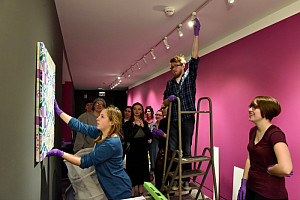

Open gallery

Art and Soul
Curating a museum exhibition is, in its own right, a form of art.
From the color on the walls to how each piece is strategically placed around a space, every small detail is debated over and refined until a consensus is reached.
“I think a lot of people don’t understand how similar curating is to making art,” says Shannon Byrne ’18. “There is a very artistic and creative process behind the entire exhibition.”
Byrne is one of the first museum studies minors at Ursinus College, a new academic minor that lecently launched. Ten students in the MS-200 course “Curatorial Studies” have curated the exhibition at the Philip and Muriel Berman Museum of Art. The exhibition, Natessa Amin: Dancing on the Water Tank, is the first solo museum exhibition for Amin, a Philadelphia-based artist who is helping to guide the students through the curatorial process with Ginny Kollak, curator of exhibitions at the Berman Museum, and Deborah Barkun, chair of the Department of Art and Art History and director of museum studies. Kollak and Barkun are co-teaching the MS-200 course.
“A lot of Natessa’s work is emotional and personal and from my own experiences as a museum goer, I like being personally attached to the work,” says Byrne, an art history and English double major. “I feel like this exhibition incorporates a lot of our own personal reactions to her work. It makes for a unique and creative experience.”
The 10 new museum studies minors returned to Ursinus before the start of the spring 2017 semester to curate the exhibition, which opened Jan. 20 and runs through June 4. The students have a hand in every part of the exhibition, including making accent wallpaper using loose pigment and water, and the design and layout of all of Amin’s painted and sculpted pieces in the gallery.
“As you turn this corner, what do you want them to see?” Amin asks the students as they decide how to position on a wall the dozen 11¾-by-8¾ drawings that are part of Amin’s series, Past for Future.
“I think this implies a certain way to view the artwork and it’s not necessarily intended that way,” Shelby Bryant ’18 says while examining one possibility. After moving some of the pieces around, the students reach a consensus.
“I think this would be a great curatorial decision,” Barkun says in approval.
Barkun notes that museum studies is growing in popularity among area liberal arts institutions.
“It’s an experiential way of learning that is very important to liberal education,” she says. “It’s not just about book learning. It’s about having a hands-on experience and learning from the artist as well as each other.”
“Instilling a sense of responsibility is also a part of the equation,” adds Kollak. “The students have learned that as curators we have a responsibility to the artists we work with and the people who visit the exhibition — mutual respect, generosity and openness is key in building that bridge.”
Barkun notes that the students in the class can draw upon experiences they had visiting Philadelphia-area museums and artist studios — including Amin’s — and have a unique opportunity to curate at the Berman Museum, which is one of about only three percent of museums nationwide accredited by the American Alliance of Museums.
Bryant, a history major who is a member of the Spring 2017 Philadelphia Experience cohort — in which students live, work and take classes in Philadelphia — is taking a Drexel University course on museum leadership this semester to continue on the museum studies track.
“I’m starting to discover who I am in the museum world and how to apply some of the basic research skills I’ve learned,” she says. “It’s really exciting to work with your peers on a project. It’s a unique experience to have so many perspectives and even be challenged on your thought process. It’s actually a lot of fun.”
In addition to curating the exhibition, the students will host several public programs, and they have designed and published a zine, or brochure, to be handed out to visitors of the exhibition.
“By working at the Berman, I get to meet artists, but I’ve never had an opportunity to work with them like this,” Statuti, an art history major, says while creating the accent wallpaper. “Instead of helping to hang up the artwork that goes on the walls, I get to make the artwork that goes on the walls and I get to design the exhibition. Not many students get this kind of opportunity.”
Amin, who was born in Pennsylvania and is a visiting artist at Moravian College, finds inspiration for her work in vibrant African textiles, Pennsylvania Dutch folk art, and the intricate details of South Asian architecture and garden design. She makes paintings and sculptures that incorporate unconventional materials such as loose pigments, silkscreen prints, flocked paper, cardboard, ceramic, and wood. Filled with vivid colors and sensuous texture, Amin’s immersive installations draw on her explorations of family history and her unique ethnic roots.
“Ever since they visited my studio, I’ve been impressed by the students’ professionalism and the research they did on my work,” Amin says. “They analyze my artwork in a way that is more sophisticated than many other art students. It’s been a fun and rewarding experience. Not every college student can say they curated a museum exhibition. It’s a creative process. I hope they feel proud and I hope it is something that continues to propel them along this path.” —by Ed Moorhouse